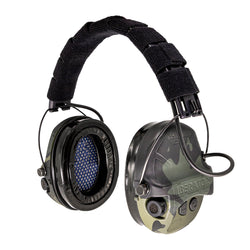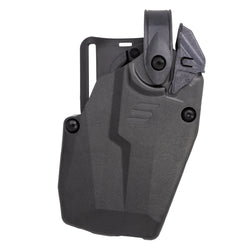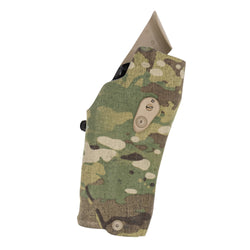Is there something special about the Ruger RXM, Glock clone pistol? There is, and it’s kind of cool, at least in my opinion.
Choosing a new handgun can feel overwhelming, especially in today’s market saturated with Glock clones. It seems nearly every firearms manufacturer offers its take on the renowned Austrian pistol. This is both good and bad because it makes the decision tougher for buyers.
Do you stick with the proven original, or venture into the world of Glock-inspired variants, which offers a few more options? Don’t get me wrong, Glock remains the gold standard, but a Glock is a Glock, and there’s not much room for options when ordering one.

This has caused many handgun manufacturers to produce their own take on the famous pistol. From dirt cheap to ticked out Gucci, there are a ton of options on the market now. But there was one big gun manufacturer that did not have a Gock clone, until now, that is.
Ruger, known for its innovation and quality, recently unveiled its RXM handgun, adding a new twist that sets it apart from other Glock clones with an interchangeable grip module system made possible by a removable trigger assembly.
Ruger RXM Overview
The Ruger was developed in partnership with Magpul, which is a smart move for both companies. Magpul has been making handgun and rifle stocks and accessories for a long time. Partnering with a company like this is smart on Ruger’s part because the possibilities for future mutations of this gun are endless.
With the RXM, Ruger utilizes a removable trigger assembly housed within the Magpul polymer grip module. This unique design enables you to easily swap out the grip modules for different sizes or colors. I can totally see a full line of colors, sizes, and even PCC platforms coming from this down the road.

The RXM is chambered in the ever-popular 9mm Luger, which is ideal for both self-defense and range practice.
They used a through-hardened alloy steel on the slide, which has a ferritic nitrocarburizing (FNC) finish. Like the slide, the barrel has an FNC finish, and the barrel has a .308 Enfield rifling, which is supposed to help reduce lead buildup in the barrel.
Look and feel of the RXM
Even though it’s a Glock clone pistol, it has a feel of its own. I think the flared mag-well makes the grip feel just a little shorter. This is fine with me as I have medium-sized hands. For those with large hands, the grip may feel just a little too small, but I’m guessing a large size frame is already in the works.
Another thing I’m liking with the RXM is the slide serrations. My Gen 5 Glock 19 doesn’t have any on the front. Ruger added some serrations on the front and back of the slide, which I kind of like. I’m used to racking the slide on 1911s and Glock 17s, so I grip the front of the slide as I rack it. This is just a preference, but why not add some serrations to the front of the slide?

Overall, the Ruger RXM is a comfortable gun to shoot. The only thing I wish they had done differently is the mag release. A big trend I noticed at SHOT 2025 was Gen-3 clones using Gen-5 mag releases. Ruger designed their own mag release, so it is easier to push than a standard Gen-3. But a Gen-5 mag release would have been perfect.
Ruger used some taller sights on the RXM, which work great for optics. The front sight is tritium, so it glows in the dark. This is a feature you normally don’t get on a factory pistol.
Ruger RXM Specs
- Caliber: 9mm
- Weight: 23 ounces (unloaded)
- Frame Material: Polymer (Magpul Grip Module)
- Slide Material: Stainless Steel
- Finish: Black Nitride
- Trigger: Removable Trigger Assembly
- Grip Module Colors: Factory Grey (additional colors available)
- Optics Compatibility: Multi-footprint Pin System
Installing an Optic on the RXM
In today’s world, most new handguns are optics-ready. Ruger not only added an optics plate, but they also used a system with locator pins to make it extremely adaptable.
This system allows the RXM to accommodate nearly every popular optic footprint on the market today. That means you can use the optics you already have, and you don’t have to buy an adapter plate. It’s a pet peeve of mine, but I can’t stand buying a new handgun and then learning I need a $100 adaptor plate to make an optic work with it. If the gun is “optics ready,” it should be just that… ready.

The optics plate on the RXM employs a clever pin system that easily adjusts to fit various optics footprints securely. Simply remove the screws from the plate, position the pins according to your optic’s footprint, and attach your red dot optic onto the slide.
I mounted my Gideon Omega on the RXM, which is a great optic and fits nicely. But like I said before, you can mount just about any popular footprint on the RXM.
Compatible Optic Footprints Include
- Trijicon RMR/SRO
- Leupold DeltaPoint Pro
- Shield RMS
- Doctor/Noblex Standard
How to Swap Out the Grip Module on the RXM
So, swapping out the grip module isn’t hard, but it’s not as easy as Sig made it either. You will need a punch, hammer, and a small bench block is preferred.
Start by removing the two pins from the left side of the grip module. Make sure the punch you are using is not too big for the small pin, or you will damage the grip module when you start beating it with a hammer. And of course, you don’t want to actually beat the pin out.

Once the pins are removed, you need to remove the take-down bar. Use the punch to place some pressure on the spring bar directly underneath and push on one side of the take-down bar. Once it starts to slide out one end of the groove, you can pull it the rest of the way out.
You can also check out this video where I swap out the grip module in about 6 minutes.
With that removed, the fire control unit can be removed as well. There are two small springs that stay in the grip module. You can leave them and use the new ones that Magpul sends out with the grips, or take them out and keep the new ones for replacement parts.
Placing the FCU into the new grip module
The two small springs that came with your grip module need to be installed first. Make sure the first spring has the forks facing the back of the gun and slide it into the grooves (see photo below). Next, drop in the spring bar with the longer “L” shape part facing down. Use the old grip module as a reference to see where it goes.

Now the fire control unit can be placed in the new grip module. Once this is done, install the take-down lever and the two pins. You may have to rotate the larger pin just a little as you’re installing it.
And that’s it. Put your slide back on and you’re ready to go. Do a quick performance check on it to make sure the trigger is functioning correctly and the slide cycles like it should.
And here’s the verdict
I think having the option to swap out grips like this on a Glock-style pistol is awesome. If someone wants a Glock 45 or some other size handgun, they will be able to purchase a grip module instead of a whole new gun.
Before I went to the range with the RXM, I used my DryFireMag training system to get a feel for the gun overall. I also used it with several of my Safariland duty holsters, and it fit all of them just fine.

At the range, I fired about 500 rounds of 9mm 115 grain Federal FMJ provided by AmmoToGo.com, so a shout out to them for the support. I won’t get into too much detail about my range time since multiple people have covered its shooting performance.
What I will say is the RXM shot great, has good recoil, and didn’t have a single hiccup. Because it’s based on the Gen-3 model, it has a single recoil spring instead of a double, but I’m not sure I could tell much difference.
I like the texturing on the grip, and the slight dip just below the trigger guard makes a notable improvement on the gun. For a handgun that retails in the $400 range, I’d say the Ruger RXM is going to be a big hit.









